Method for testing pipeline welds using ultrasonic phased arrays
a phased array and pipeline technology, applied in the direction of instruments, magnetic property measurements, processing detected response signals, etc., can solve the problems of restricted limits on the accuracy of these methods, and the general less suitable of compression waves (longitudinal waves)
- Summary
- Abstract
- Description
- Claims
- Application Information
AI Technical Summary
Benefits of technology
Problems solved by technology
Method used
Image
Examples
first embodiment
[0075]The method of non-destructive testing of the weld is performed solely by means of inspecting the weld joint with ultrasonic probes. An NOT method according to the invention will now be described with reference to FIG. 3.
[0076]FIG. 3 shows two ultrasonic transducer arrays 8a, 8b used in the NDT method. The arrays 8a, 8b are arranged on the pipe sections 2 on opposite sides of the weld joint. Each array is in the form of a 90 mm phased array R / D Tech probe available from Olympus Corporation. The arrays operate at a frequency of about 4 MHz and are provided with a rexolyte wedge having an angle of about 21°. Each phased array unit 8a, 8b has two banks of 30 transducer elements. Thus with two phased array units 8a, 8b there are a total of 120 transducer elements, 60 upstream of the weld joint and 60 downstream. In addition to the phased array probes 8a, 8b there is also mounted ultrasonic probes 9a and 9b dedicated to generating surface waves 7. A further set of ultrasonic probes ...
second embodiment
[0097]In this second embodiment, the pipe has a diameter of about 300 mm, a wall thickness of about 22 mm+3 mm (cladding), and a bevel angle of about 8 degrees to the vertical.
[0098]The second embodiment utilises 126 transducer elements, 63 arranged upstream and 63 arranged downstream. Of those elements six individual transducer elements are provided (three upstream and three downstream) separately from the upstream and downstream phased arrays, which are each provided by 60 elements. The transducer elements scan the weld and produce measurements on about 50 separate measurement channels. The elements of the phased arrays are able, by means of operating under different focal laws, to emit ultrasonic beams at angles varying from 45 to 70 degrees (in this case the angle being 90 degrees when perpendicular to the surface and 0 degrees when parallel). Surface waves are also able to be transmitted. For non-surface wave inspections, the path length of the radiation may range from about 10...
third embodiment
[0104]FIG. 5 shows a calibration block for use in the invention. The block includes machined holes at the bottom of each of which there is a flat bottomed hole. The face of the flat bottomed hole is aligned with the geometry of the bevel and acts as a reflector, simulating a defect of a known shape and size. The block also includes notches 14cn1, 14cn2, 14cn3, 14rn1, 14rn2, 14rn3 in the cap and root regions, simulating defects near the inner and outer pipe diameters. The various reference numerals used in FIG. 5 are summarised as follows:
[0105]
Cap Notches 1 to 314cn1, 14cn2, 14cn2Cap14cFill layers 1 to 714f1 to 14f7Hot Pass14hRoot14rRoot Notches 1 to 314rn1, 14rn2, 14rn3
[0106]The calibration block is used to generate a look-up table for use when performing NDT inspections on a pipe having a bevel geometry and material composition corresponding to that of the calibration block. For each measurement made during the NDT method, a reflector is provided in the calibration block to simula...
PUM
| Property | Measurement | Unit |
|---|---|---|
| size | aaaaa | aaaaa |
| incident angle | aaaaa | aaaaa |
| depth | aaaaa | aaaaa |
Abstract
Description
Claims
Application Information
 Login to View More
Login to View More - R&D
- Intellectual Property
- Life Sciences
- Materials
- Tech Scout
- Unparalleled Data Quality
- Higher Quality Content
- 60% Fewer Hallucinations
Browse by: Latest US Patents, China's latest patents, Technical Efficacy Thesaurus, Application Domain, Technology Topic, Popular Technical Reports.
© 2025 PatSnap. All rights reserved.Legal|Privacy policy|Modern Slavery Act Transparency Statement|Sitemap|About US| Contact US: help@patsnap.com



